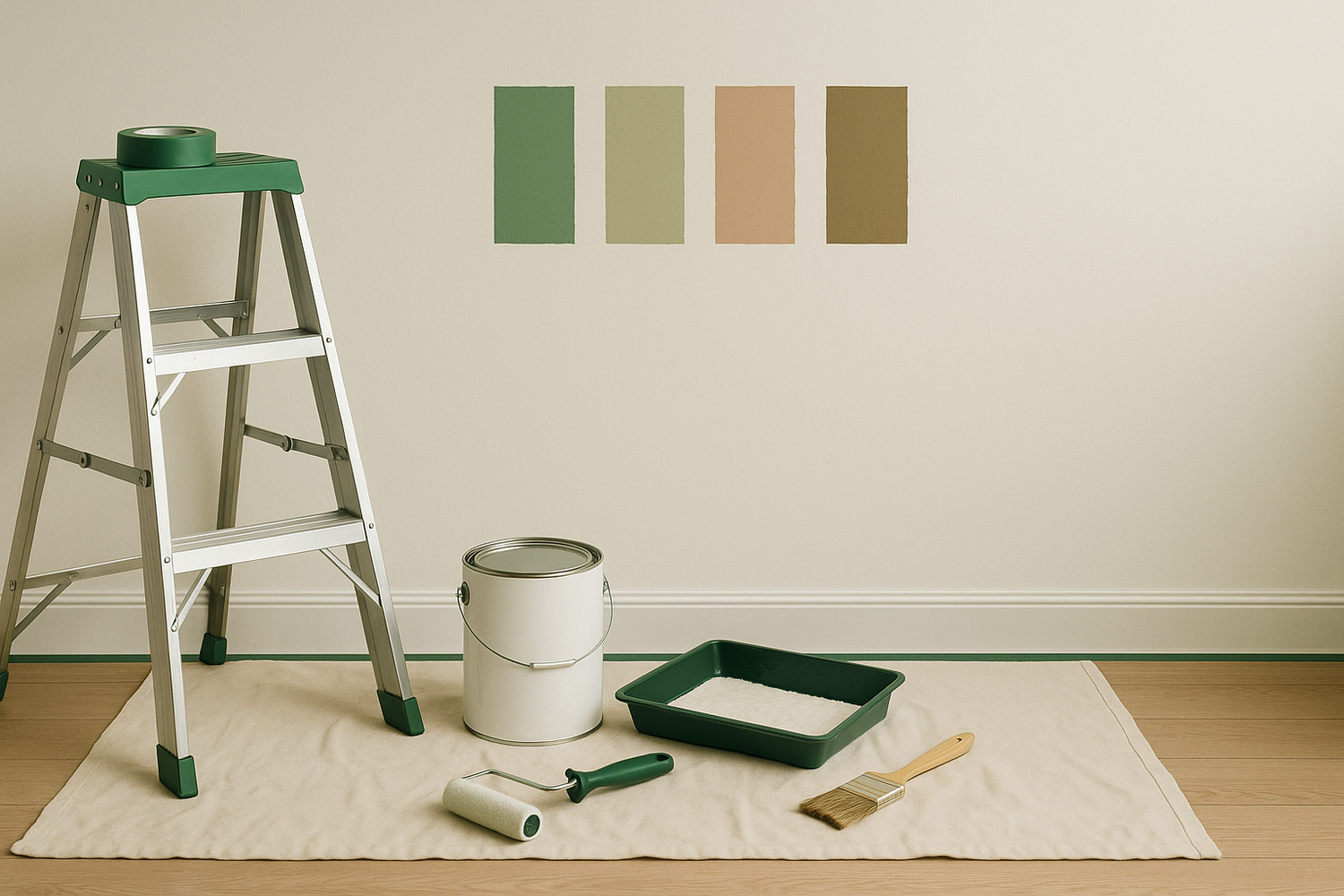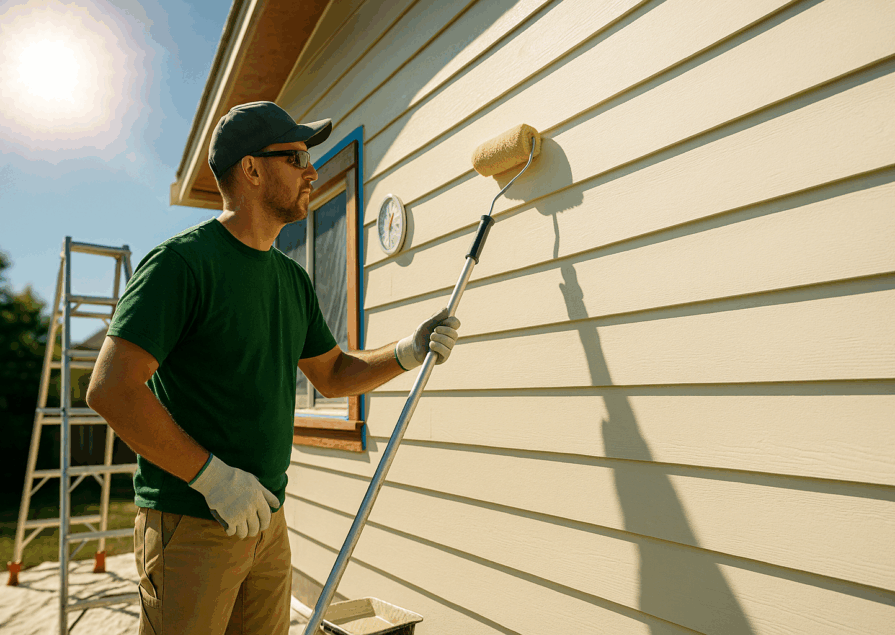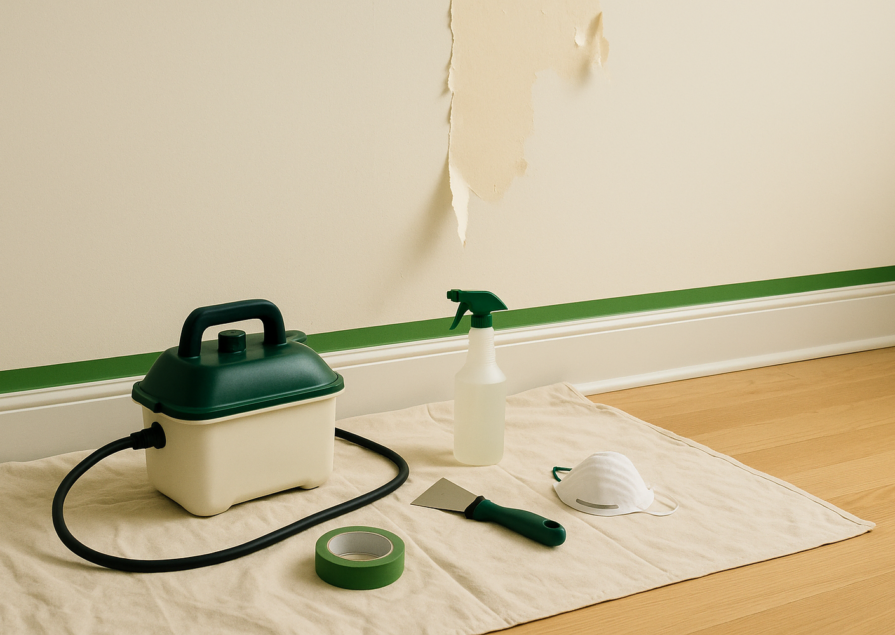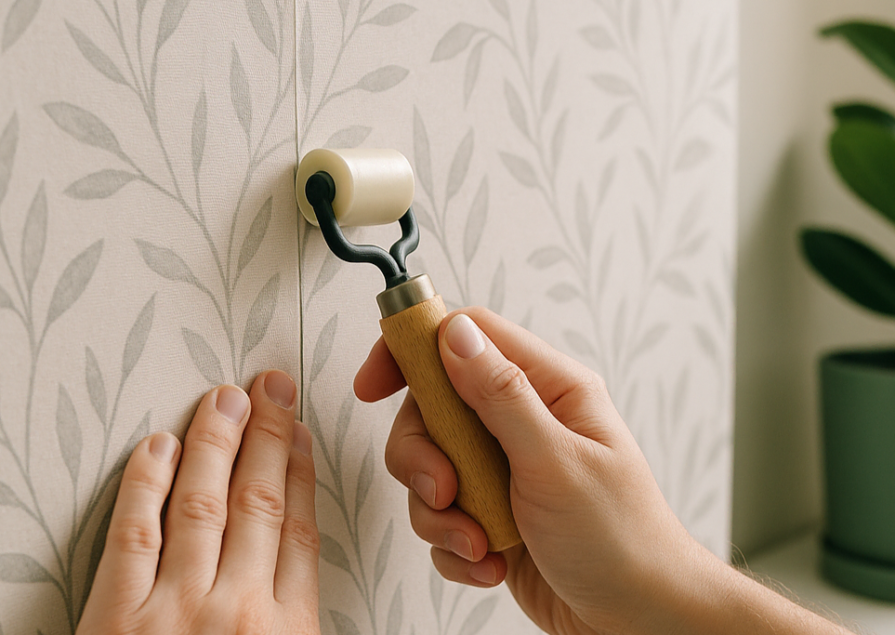When you’re painting in bone-dry conditions, it’s like trying to ice a cake in the desert – everything works against you. Whether you’re a weekend warrior tackling your home’s exterior in Phoenix or a pro contractor working the oil patch in Alberta, dry climate painting demands specialized tools and rock-solid techniques.
The reality hits hard: paint applied in low humidity conditions dries up to 50% faster than normal, creating a perfect storm of application nightmares. Your paint starts skinning over before you can spread it properly, dust settles into your wet finish like sprinkles on a donut, and that beautiful smooth coat you’re after becomes as elusive as rain in the Sahara.
But here’s the thing – armed with the right arsenal of tools and know-how, you can nail professional results even when Mother Nature’s throwing her worst curveball. This comprehensive guide cuts through the fluff to deliver the essential gear, proven techniques, and insider secrets that separate the pros from the weekend warriors in arid conditions.
Understanding the Unique Challenges of Painting in Dry Climates
Painting in dry areas isn’t just regular painting with less moisture – it’s a completely different beast that’ll humble even seasoned pros if they’re unprepared. The triple threat of low humidity, temperature extremes, and airborne contaminants creates a perfect storm that can turn your paint job into an expensive do-over.
Let’s break down exactly what you’re up against and why your usual painting playbook gets tossed out the window when the humidity drops below 40%.
How Low Humidity Affects Paint Application
Low humidity is like putting your paint on fast-forward – everything happens too quickly for proper application. When relative humidity drops below 30%, paint dries increasingly fast as it attempts to create atmospheric balance by releasing moisture into the dry air.
Here’s what actually happens to your paint in low-humidity conditions:
- Flash Drying: Paint can dry so quickly that brush strokes become permanent, preventing proper leveling and creating visible texture marks
- Reduced Adhesion: When paint dries too rapidly, it doesn’t have time to properly wet and bond with the surface
- Colour Inconsistency: Fast evaporation can concentrate pigments unevenly, leading to streaky or blotchy finishes
- Shorter Working Time: Your “open time” for blending and touch-ups shrinks dramatically
Fun Fact: Professional artists working in high-humidity studios can keep acrylic paint workable for over 15 minutes, while the same paint in low humidity conditions becomes unworkable in just 2-3 minutes.
The sweet spot for most painting applications is 40-50% relative humidity according to multiple industry sources. When you’re working below this range, you need specialized tools and techniques to compensate.
Practical Impact on Tool Selection:
- Standard synthetic brushes become less effective as paint stiffens quickly
- Roller covers need deeper nap to hold more paint for rapid application
- Paint tray systems require covers to prevent skinning
- Spray equipment needs adjusted pressure settings for proper atomization
Temperature Extremes and Paint Performance
Temperature swings in dry climates can make paint behave like a completely different material. When temperatures exceed 90°F (32°C), paint surfaces can reach over 110°F (43°C), causing paint to “skin over” before underlying layers cure properly.
High Temperature Effects:
- Surface Skinning: Paint forms a film on top while underneath layers remain wet, creating wrinkles, bubbles, and poor adhesion
- Viscosity Changes: Paint becomes thinner and runnier, making even coverage difficult
- Flash Rusting: On metal surfaces, rapid moisture loss can trigger immediate corrosion
- Tool Degradation: Brushes dry out faster, and rubber seals in spray equipment can fail
Temperature Cycling Challenges: Desert and prairie regions often see 30-40°F (17-22°C) temperature swings between day and night. This expansion and contraction can:
- Cause fresh paint to crack as it cures
- Create condensation issues during cool mornings
- Affect paint flow characteristics throughout the day
Pro Quote:“In Nevada, I’ve seen surface temps hit 140°F on a black roof. At those temperatures, you’re not painting – you’re baking. The paint literally bubbles like pancake batter.” – Mike Rodriguez, Commercial Painter
Optimal Temperature Windows:
- Oil-based paints: Minimum 45°F (7°C) for 48 hours after application
- Latex/Acrylic: Above 50°F (10°C) with stable temperatures preferred
- Surface temperature: Should not exceed 100°F (38°C) for most formulations
Dust and Wind Contamination Issues
Dust is the silent killer of paint jobs in dry areas. Dust-producing surfaces cover one-third of the global land area, with hyper-arid regions like deserts and drylands creating constant airborne contamination.
Primary Contamination Sources:
- Wind-blown soil particles from exposed ground
- Construction dust from ongoing development
- Agricultural debris from farming operations
- Vehicle traffic on unpaved roads
- Industrial emissions from nearby facilities
How Dust Ruins Paint Jobs:
- Crater Formation: Large particles create dimples and craters in wet paint
- Texture Issues: Fine dust creates a sandpaper-like surface texture
- Adhesion Problems: Dust prevents proper paint-to-surface bonding
- Colour Contamination: Light-coloured dust visibly alters paint colour
Industry Insight: Environmental contaminants like dust and debris settling on wet paint surfaces is the leading cause of refinish failures in automotive applications.
Dust Particle Size Impact:
- Large particles (50+ microns): Create visible defects and craters
- Fine dust (10-50 microns): Causes texture and sheen variations
- Ultra-fine particles (<10 microns): Penetrate paint film and affect curing
Wind Speed Considerations:
- Light breeze (5-10 mph): Generally manageable with proper techniques
- Moderate wind (10-20 mph): Requires dust barriers and modified spray patterns
- Strong wind (20+ mph):Stop painting immediately – contamination risk too high
Seasonal Dust Patterns: Different regions have predictable dust seasons that smart contractors plan around:
- Southwest US: Peak dust season March-June during dry, windy spring weather
- Canadian Prairies: Worst conditions during harvest season (August-October)
- Australian Outback: Year-round challenges with seasonal intensity variations
Tool Selection for Dust Control:
- Air filtration systems for enclosed work areas
- Tack cloths and microfiber wipes for frequent surface cleaning
- Quick-setting primers to minimize contamination windows
- Spray shields and tarps to create clean application zones
The bottom line? Understanding these three environmental factors is crucial for selecting the right tools and techniques. Each challenge requires specific equipment solutions, and the best contractors adapt their entire toolkit to match the conditions they’re facing.
Essential Hand Tools for Dry Area Painting
When humidity drops and temperatures soar, your basic brush-and-roller setup becomes about as useful as a chocolate teapot. The secret to conquering dry climate painting lies in choosing hand tools specifically engineered to handle rapid drying conditions and dust contamination.
Smart contractors know that the right hand tools can make the difference between a professional finish and an expensive redo. Here’s the insider knowledge on what actually works when the going gets tough.
Specialized Brushes for Arid Conditions
Not all brushes are created equal when you’re battling bone-dry air and scorching surfaces. The brush that works beautifully in humid Vancouver will leave you cursing in Phoenix.
Natural vs. Synthetic Bristles in Dry Heat:
| Brush Type | Dry Climate Performance | Best Applications |
| China Bristle (Natural) | Excellent heat resistance, maintains shape | Oil-based paints, high-temp surfaces |
| Synthetic Blend | Good overall performance | Latex paints, moderate conditions |
| Pure Nylon | Poor in extreme heat, bristles soften | Avoid in temperatures above 85°F |
| Polyester Blend | Best all-around choice | Universal applications, maintains stiffness |
Top Performer:Purdy White Dove or Wooster Ultra/Pro series – these professional-grade synthetic blends maintain their shape and stiffness even when surface temps hit 120°F (49°C).
Angled Brushes for Quick Coverage:
- 2.5-3 inch angled sash brushes are your workhorses for rapid application
- 45-degree angle provides maximum paint loading while maintaining control
- Flagged tip bristles help paint flow smoothly despite fast drying times
Brush Storage and Maintenance in Dry Conditions:
- Never leave brushes exposed – dry air will ruin them in minutes
- Use brush keepers or wet rags between coats
- Clean immediately after use with appropriate solvents
- Store in sealed containers with damp paper towels to maintain flexibility
High-Performance Rollers and Covers
Standard roller covers are basically useless in dry climates – they don’t hold enough paint, and they create texture issues when paint dries too quickly.
Microfiber Covers for Smooth Finishes:
- Microfiber technology holds 30-40% more paint than standard covers
- Ultra-smooth finish with minimal stipple texture
- Self-releasing – paint flows off evenly despite rapid drying
- Best choice: Purdy Golden Eagle or Wooster Micro Plush
Nap Selection Strategy:
- 1/4″ nap: Smooth surfaces, interior walls in controlled environments
- 3/8″ nap:Most versatile for dry climates – good paint capacity with smooth finish
- 1/2″ nap: Textured surfaces, siding, rough concrete
- 3/4″+ nap: Only for heavily textured surfaces – too much texture for most applications
Anti-Static Roller Frames: Dust attraction is a major issue with standard plastic frames. Metal frames with anti-static coatings reduce dust pickup by up to 70%.
Frame Features for Dry Climates:
- Heavy-duty construction to handle thicker paint loads
- Quick-release mechanism for rapid cover changes
- Ergonomic handles – you’ll be working faster to beat the drying time
- Professional grade: Wooster Sherlock or Purdy Revolution
Professional-Grade Paint Trays and Liners
Your paint tray becomes mission-critical in dry conditions – standard trays allow paint to skin over in minutes, wasting material and creating application problems.
Deep-Well Trays to Prevent Rapid Drying:
- 4-inch deep wells vs. standard 1.5-2 inch depth
- Larger paint reservoir means less frequent refilling
- Better temperature stability – more thermal mass
- Top choice: Wooster Big Ben or Purdy Revolution Tray
Disposable Liner Systems:
- Plastic liners protect tray and enable quick colour changes
- Pre-formed liners fit perfectly and don’t bunch up
- Solvent-resistant materials for oil-based applications
- Cost-effective – cleanup time is money in hot weather
Tray Covers and Preservation Methods:
- Wet towels over paint surface between coats
- Plastic wrap creates airtight seal
- Spray bottles for misting paint surface
- Cooler storage for extended breaks
Money-Saving Tip: A $2 plastic liner can save 15 minutes of cleanup time. When you’re racing against 100°F+ heat, that’s pure profit.
Power Tools and Equipment for Dry Climate Painting
When hand tools hit their limits, power equipment becomes your ace in the hole. But not just any sprayer or mixer will cut it – dry climate conditions demand tools engineered for rapid application and consistent performance under extreme conditions.
Airless Paint Sprayers: Pros and Cons in Dry Areas
Airless sprayers can be either your best friend or worst nightmare in dry climates, depending on setup and technique.
Advantages in Dry Conditions:
- Speed of application – covers large areas before paint can skin over
- Consistent mil thickness regardless of drying conditions
- Deep penetration into surface irregularities
- No air introduction – reduces contamination from airborne dust
Disadvantages and Challenges:
- Overspray issues magnified by wind conditions
- Pressure adjustments needed for temperature variations
- Clogging problems with fast-drying paints
- Cleanup urgency – equipment must be cleaned immediately
Optimal Settings for Dry Climates:
| Paint Type | Pressure (PSI) | Tip Size | Spray Pattern |
| Latex Interior | 1800-2200 | 0.015-0.017 | 12-15 inches |
| Latex Exterior | 2200-2800 | 0.017-0.021 | 15-18 inches |
| Oil-Based | 2000-2500 | 0.015-0.019 | 12-16 inches |
| Primer | 2400-3000 | 0.019-0.023 | 18-21 inches |
Top Performers for Dry Climates:
- Graco Ultra Max II 1595 – proven workhorse with consistent pressure
- Titan ControlMax 1700 – excellent for DIY and light commercial
- Wagner Control Pro 350 – budget option with good performance
HVLP Systems for Controlled Application
High Volume Low Pressure (HVLP) systems shine in dusty, windy conditions where overspray control is critical.
Key Advantages:
- Reduced overspray by up to 65% compared to conventional guns
- Better transfer efficiency – more paint reaches the surface
- Controlled atomization works better in variable conditions
- Less bounce-back reduces contamination from airborne particles
HVLP Setup for Dry Climates:
- Air cap selection: Larger caps (1.7-2.0mm) for faster coverage
- Pressure settings: 8-12 PSI at the cap for optimal atomization
- Fluid tip matching: Match tip size to paint viscosity and desired flow
- Air filtration: Essential to prevent contamination
Dust Contamination Prevention:
- Inline air filters remove particles before they reach the gun
- Moisture traps prevent condensation in air lines
- Regular maintenance – clean air passages frequently
Technical Insight: HVLP systems use 90% less compressed air than conventional spray guns, reducing the chance of stirring up dust and debris around the work area.
Paint Mixers and Agitators
Paint consistency becomes critical in dry climates – temperature swings and rapid solvent evaporation can turn perfectly good paint into unusable sludge.
Maintaining Paint Consistency in Heat:
- Temperature-controlled storage keeps paint at optimal viscosity
- Regular agitation prevents settling and separation
- Viscosity testing ensures consistent application properties
- Additive management – flow agents and retarders must be properly mixed
Portable Mixing Solutions:
- Drill-powered mixers with variable speed control
- Pneumatic mixers for larger volumes
- Paddle designs optimized for paint types
- Explosion-proof motors for solvent-based applications
Anti-Settling Equipment:
- Automatic agitators for large containers
- Recirculation pumps keep paint moving
- Temperature monitoring prevents overheating
- Timer controls for consistent mixing cycles
Recommended Equipment:
- Jiffy Mixer Model HS-1 – variable speed, robust construction
- Arrow Engineering pneumatic mixers – explosion-proof options
- Graco Paint Shaker – for smaller containers
Surface Preparation Tools for Harsh Environments
Surface prep in dry climates is like preparing for battle – the environment works against you at every turn, but proper preparation tools can turn the tide in your favour.
Power Washing Equipment
Getting surfaces clean in dusty, dry conditions requires serious firepower, but you need to balance cleaning effectiveness with water conservation and drying time optimization.
PSI Requirements for Dry Climate Preparation:
| Surface Type | Minimum PSI | Optimal PSI | Nozzle Tip | Special Considerations |
| Wood Siding | 1200 | 1500-2000 | 25-40° | Avoid splintering dried wood |
| Stucco/Concrete | 2000 | 2500-3000 | 15-25° | Remove embedded dust |
| Metal Surfaces | 1500 | 2000-2500 | 15-25° | Remove oxidation and chalking |
| Masonry | 2500 | 3000-3500 | 15° | Deep cleaning of porous surfaces |
Water Conservation Techniques:
- Pre-sweep surfaces to remove loose debris before washing
- Sectional washing – work in manageable areas to prevent waste
- Recycling systems for non-contaminated rinse water
- Biodegradable detergents that break down quickly in arid soils
Drying Time Optimization:
- Morning washing takes advantage of rising temperatures
- Air movement – use fans or natural breeze to accelerate drying
- Surface temperature monitoring – ideal washing when surfaces are 70-85°F (21-29°C)
- Weather timing – avoid washing before windstorms
Water Conservation Fact: Proper pre-cleaning can reduce water usage by up to 40% while achieving better cleaning results than pressure washing alone.
Professional Equipment Recommendations:
- Simpson MegaShot 3200 PSI – reliable gas-powered unit
- Sun Joe SPX3000 – electric option for smaller jobs
- Pressure-Pro E4042HG – heavy-duty commercial grade
Scrapers and Sanders Built for Durability
Standard scrapers and sanders give up the ghost in harsh conditions – dust clogs motors, heat warps handles, and abrasive surfaces chew through components.
Heat-Resistant Hand Tools:
| Tool Type | Standard Rating | Dry Climate Rating | Key Features |
| Pull Scrapers | 80°F handle comfort | 120°F+ with proper grips | Ergonomic, heat-dissipating handles |
| Push Scrapers | 6-inch standard | 4-inch for better control | Shorter blades reduce binding |
| Detail Scrapers | Plastic handles | Metal with rubber grips | Won’t soften in extreme heat |
Power Sanders for Extreme Conditions:
- Dust-sealed motors prevent premature failure
- Heavy-duty bearings handle thermal expansion
- Oversized dust collection manages high particle loads
- Heat-dissipating designs prevent overheating
Top Performers:
- Festool RO 150 FEQ – sealed system with excellent dust collection
- Bosch ROS20VSC – variable speed with dust canister
- DeWalt DWE6423K – affordable option with good heat tolerance
Blade and Abrasive Selection:
- Carbide scrapers maintain sharp edge in extreme conditions
- Open-coat sandpaper resists loading in dusty conditions
- Mesh abrasives allow dust to pass through
- Silicon carbide for aggressive material removal
Dust Collection and Cleanup Systems
Dust control isn’t optional in dry climates – it’s the difference between a professional job and starting over.
Shop Vacuums with HEPA Filtration:
- True HEPA filters capture 99.97% of particles 0.3 microns or larger
- Multi-stage filtration prevents motor damage
- Large capacity reduces emptying frequency
- Anti-static hoses prevent dust attraction
Dust Containment Barriers:
- Plastic sheeting systems create clean zones
- Magnetic strips for easy attachment to metal surfaces
- Weighted bottoms prevent wind lifting
- Tear-resistant materials withstand handling
Pre-Painting Cleanup Protocols:
- Vacuum all surfaces with brush attachment
- Tack cloth treatment with proper solvent
- Air blow-down with clean, dry compressed air
- Final inspection under proper lighting
- Immediate paint application to prevent recontamination
Professional Cleanup Equipment:
- Shop-Vac 12-gallon 6.5 HP – powerful suction for heavy debris
- Festool CT 48 E – professional grade with auto-start
- Ridgid WD1450 – wet/dry capability for versatile use
Pro Secret: Use a leaf blower in reverse (vacuum mode) for quick dust removal from large areas before detailed cleaning.
Environmental Control and Protection Tools
When you can’t control Mother Nature, you create your own microclimate. Smart contractors use environmental control tools to create ideal painting conditions even when the weather’s working against them.
Temporary Shade Structures and Wind Barriers
Direct sunlight and wind are paint job killers in dry climates. Professional-grade shade and wind protection systems can extend your working window and dramatically improve finish quality.
Portable Shade Solutions:
- Pop-up canopies (12×12 or larger) for immediate coverage
- Retractable awning systems for larger areas
- Shade cloth (70-90% UV blocking) draped over scaffolding
- Reflective tarps to redirect heat away from work surfaces
Wind Barrier Systems:
- Mesh windscreens reduce wind speed by 50-80%
- Solid barriers for complete protection but may create turbulence
- Portable fence panels that stack and store easily
- Weighted base systems that won’t blow over
Setup Strategies:
- East-side morning protection as sun rises
- West-side afternoon coverage during peak heat
- Multi-directional wind breaks for variable wind conditions
- Equipment staging areas to protect tools and materials
Engineering Fact: A 50% reduction in wind speed can extend your spray painting window by up to 3 hours per day in typical dry climate conditions.
Humidity Control Equipment
Creating your own humidity bubble can turn impossible painting conditions into manageable ones.
Portable Humidifiers for Enclosed Areas:
- Ultrasonic humidifiers for precise control
- Evaporative coolers that add moisture while reducing temperature
- Steam generators for rapid humidity increase
- Capacity sizing: 1 gallon per 500 sq ft for effective coverage
Moisture Meters and Monitoring:
- Digital hygrometers with data logging capability
- Wireless monitoring systems for remote reading
- Alert systems when conditions move outside optimal ranges
- Calibration tools to ensure accuracy
Optimal Humidity Range Maintenance:
- Target range: 40-60% relative humidity
- Monitoring frequency: Every 15 minutes during application
- Adjustment protocols for different paint types
- Documentation for warranty and quality assurance
Professional Equipment:
- Aprilaire 600M – whole-house humidifier for large areas
- Honeywell HCM-6009 – quiet operation for occupied spaces
- General Tools Digital Hygrometer – accurate, affordable monitoring
Temperature Management Solutions
Thermal control is critical when surface temperatures can swing 40°F (22°C) in a single day.
Cooling Systems for Work Areas:
- Evaporative coolers – effective in dry climates, add beneficial humidity
- Portable air conditioners for enclosed spaces
- Misting systems for personal cooling without affecting surfaces
- Reflective ground covers to reduce radiant heat
Paint Storage Temperature Control:
- Insulated storage containers maintain consistent temperatures
- Thermal blankets for paint buckets during breaks
- Cooler storage for small quantities of specialty products
- Temperature monitoring with min/max recording
Thermal Protection for Equipment:
- Shade covers for spray equipment
- Thermal wraps for hoses and lines
- Heat shields for compressors and motors
- Ventilation systems for enclosed tool storage
Surface Temperature Management:
- Surface thermometers for accurate readings
- Cooling techniques – wet towels for small areas
- Timing strategies to work within optimal temperature windows
- Pre-conditioning – misting surfaces to moderate temperature
Temperature Management Tip: Paint stored at 70°F (21°C) will have 30% better flow characteristics than the same paint at 100°F (38°C).
Specialized Paints and Primers for Dry Climates
Your standard paint selections get tossed out the window when dealing with bone-dry conditions and temperature extremes. Success demands specialized formulations engineered specifically for arid climate challenges.
Slow-Drying Paint Formulations
Extended open time is worth its weight in gold when humidity levels drop below 30% and surface temperatures soar past 100°F (38°C).
Key Additive Technologies:
| Additive Type | Function | Typical Usage Rate | Best Applications |
| Floetrol (Latex) | Extends open time, improves flow | 8-16 oz per gallon | Interior/exterior latex paints |
| Penetrol (Oil) | Reduces brush marks, slows drying | 8-16 oz per gallon | Oil-based paints and stains |
| XIM X-Tender | Professional-grade extender | 6-12 oz per gallon | High-end architectural coatings |
| Glycol Ethers | Moisture retention, flow enhancement | 2-4% by volume | Custom formulations |
Manufacturer-Specific Slow-Dry Options:
- Benjamin Moore Advance – Self-leveling alkyd with extended open time
- Sherwin-Williams ProClassic – Hybrid formulation with 30% longer working time
- Behr Premium Plus Ultra – Contains built-in open time extenders
- PPG Manor Hall – Engineered for extreme climate performance
Application Considerations:
- Reduce coverage rates by 10-15% to allow proper flow and leveling
- Work in smaller sections even with extended open time
- Temperature monitoring – additives work best between 70-85°F (21-29°C)
- Compatibility testing before adding to entire batch
Paint Chemistry Insight: Glycol ether additives can extend latex paint open time by up to 300% in low-humidity conditions while maintaining film integrity.
Primer Selection for Arid Conditions
Primer choice can make or break your paint job in challenging dry climates. The right primer provides a stable foundation that withstands thermal cycling and moisture variations.
Penetrating vs. Bonding Primers:
Penetrating Primers (Best for Porous Surfaces):
- Oil-based alkyd primers – deep penetration, excellent adhesion
- Modified acrylic primers – faster drying with good penetration
- Shellac-based primers – superior stain blocking and adhesion
- Best for: Raw wood, masonry, previously painted chalky surfaces
Bonding Primers (Best for Non-Porous Surfaces):
- 100% acrylic bonding primers – flexible, UV resistant
- Epoxy-based primers – industrial strength adhesion
- Specialty metal primers – corrosion inhibiting properties
- Best for: Glossy surfaces, metal, vinyl, previously painted smooth surfaces
UV Resistance Properties: Critical in high-altitude and desert environments where UV exposure is extreme.
- Titanium dioxide content should be 15% or higher
- UV stabilizers prevent breakdown of binder resins
- Colour stability maintains hiding power over time
- Chalking resistance prevents surface deterioration
Dust-Resistant Formulations:
- Quick-tack properties seal surfaces before contamination
- Self-cleaning additives allow dust to wash away naturally
- Anti-static properties reduce dust attraction during curing
- Smooth finish primers minimize dust adherence points
Professional Primer Recommendations:
| Surface Type | Top Choice | Key Benefits | Coverage Rate |
| Raw Wood | Zinsser Cover Stain | Oil-based, deep penetration | 300-400 sq ft/gal |
| Masonry | KILZ Concrete & Masonry | Alkali resistant, moisture blocking | 250-350 sq ft/gal |
| Metal | Corroseal Water-Based Metal Primer | Direct-to-metal, rust converting | 350-450 sq ft/gal |
| Problem Surfaces | Zinsser Bulls Eye 1-2-3 | Universal bonding, stain blocking | 350-400 sq ft/gal |
Pro Specification: In extreme dry climates, always use a primer with at least 25% higher solids content than standard formulations to ensure adequate film build.



